Veiled Chameleon Care
Veiled chameleons are medium to large lizards found most commonly in the wild in the Arabian Peninsula, in parts of Yemen and Saudi Arabia. The Veiled chameleon (Chamaeleo calyptratus) – also known as the Yemen chameleon -) has become the most popular chameleon pet due to its size and bright colours. Veiled chameleon care is simple – if done correctly. (The term ‘pet’ is misleading – see below).
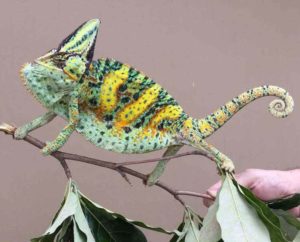
The requirements may be simple but getting one wrong could spell disaster, which is why it’s important to spend time learning how to provide the best Veiled chameleon care possible.
Veiled chameleons are fairly resilient, tolerating a reasonably wide range of conditions. This is not surprising when one considers the native Veiled chameleon habitat in the Yemen.
In the Yemen, Veiled chameleons are subjected to extreme summer heat and very low winter temperatures. Food can be abundant or scarce, which may be behind one of its biggest problems in captivity.
Veiled chameleons are the species most prone to metabolic bone disease (MBD), almost always caused by incorrect care. This is covered in more detail below.
Veiled chameleons are not the best-tempered chameleons. Some accept handling better than others. A few are too aggressive to be handled.
Where do Veiled Chameleons come from?
Veiled chameleons are found in a variety of habitats in Yemen and Saudi Arabia. They are arboreal, leading a solitary existence in trees or large bushes (until mating season). They are found from sea level to elevations over 3,000 feet.
(Feral Veiled chameleons that escaped in other countries, particularly the US, have adapted to a wider habitat and are found up to elevations of 12,000 feet!)
In Yemen and Saudi Arabia, Veiled chameleons may be found in plateaus and valleys in the hills and mountains. In the wet season, the valleys or Wadis become runways for the heavy rain, transforming the otherwise barren scenery into regions and oases of lush of plant life.
Newly hatched chameleons have no difficulty in finding an abundance of food. But the rains don’t last long nor does the great quantity of food, so the youngsters must eat as much as they can and as quickly as they can to reach maturity while they have the chance. In the wild that’s fine but in captivity it’s the cause of one the Veiled chameleons’ biggest problems – that same instinct of overeating is often the cause of MBD.
Unlike many chameleon species, the International Union for Conservation of Nature (IUCN) classifies the veiled chameleon as of Least Concern on its IUCN Red List.
The wild populations appear stable, although with the ongoing political unrest and civil war in Yemen, this information is not verified. The unsettled politics in Yemen have prevented the export of chameleons, so no new bloodlines are appearing.

How big do Veiled chameleons get?
A full-grown male Veiled chameleon can grow to between 45cm and 60cm in length (from the tip of the tail to the end of its snout). Female Veiled chameleons are smaller, typically around 35cm in length.
Both sexes have a casque (sometimes referred to as a helmet) which is the origin of its name Veiled chameleon. The shape of the casque is also responsible for another name – the Cone-shaped chameleon.
The casque grows as the chameleon matures but remains relatively small when compared to the males. A large adult male Veiled chameleon casque can be 5cm long.
Due to their size, a well-ventilated cage measuring at least 80cm by 60cm by 80cm high would be sufficient but larger would be better. The layout of the cage is important to ensure the correct Veiled chameleon care.
On hatching, baby Veiled chameleons are a little over 6cm long on hatching. The size may vary based on several husbandry factors. One thing is sure – they grow fast.
Unless very young, Veiled chameleons should not be kept together, even in pairs, as they can be aggressive to each other.
How long do Veiled chameleons live?
The lifespan of a Veiled chameleon varies considerably due to the conditions they are kept in and their sex. Typically, the lifespan of a female will be 3 to 5 years, whereas a male might live 6 to 8 years. I’ve heard of some living as long as 9 years but that’s exceptional. And that’s important to remember about the lifespan of a Veiled chameleon – there are always exceptions.
What is the ideal Veiled chameleon temperature?
There is a general view that as these chameleons come from the Yemen, they must experience and need high temperatures all year round. This is incorrect and can be detrimental to the health of the chameleon. The Yemen, like most places in the Middle East, has strong seasonal variations in temperatures. As mentioned above, days in summer can be hot but nights in the winter can be rather cool.
Seasonal variation is needed to mirror their natural conditions, but that can be hard to replicate in captivity. I managed it to a certain extent on the Highveld in South Africa by keeping mine outdoors for much of the year, even on mild winter days. As a result, my breeding pairs were healthier than those kept at a constant temperature year round. They produced more eggs, with a better hatch rate than other Veiled chameleon breeders who kept theirs at a constant temperature.
A temperature range of 15°c at night and 25 to 30°c during the day would be reasonable. Extremes should be avoided but the chameleons will take lower temperatures during the winter.
Remember that, while temperatures in Yemen may be high in summer, a wild chameleon can hide or take evasive action to avoid the heat. In a cage it can’t escape the heat even if it wanted to.
(For example, wild Flap Neck chameleons on the Highveld in South Africa can survive temperatures down to -8c in winter. That would impossible in a cage in captivity.)
What do Veiled chameleons eat?
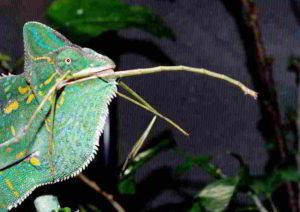
A veiled chameleon diet should be as varied as much as possible but crickets normally provide the basic staple diet. These chameleons are insectivorous. While they may occasionally eat vegetation, such as flowers or diced carrots, this should only be a small part of the food provided for Veiled chameleons.
In South Africa, my Veiled chameleons rarely ate vegetation, fruit or flowers. In Malaysia, they demolished small Hibiscus bushes in a matter of weeks! I bred the same insects in both locations, so the chameleon diet was similar. Why the difference? A genetic preference?
MBD is due to calcium deficiency and the Veiled chameleon is very prone to this problem for various reasons.
How can I avoid my Chameleon getting MBD?
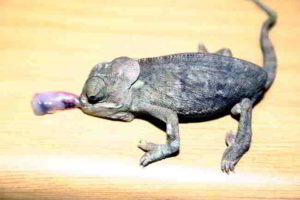
Unlike their rainforest cousins, food supplies may be irregular in the Yemen. This results in a Veiled chameleon eating whenever it comes across insects. And as many as it finds. If an owner is not careful, this tendency can cause their chameleon to grow too fast. In extreme cases, the chameleon will not be able to assimilate the calcium fast enough to generate strong bones.
Sadly, ignorance of this risk is one of the main causes of MBD. I have heard of chameleon keepers in Malaysia bragging about how fast their lizard was growing. Only to hear a few months later that it was either dead or dying due to MBD.
Hatchlings should be fed as much as they need. When the baby Veiled chameleons are a month or so old (and obviously healthy), one day a week without food will be beneficial.
Adults can be fed every other day. Gravid females should be fed daily but with good quality food and supplements.
Vitamin and calcium supplements are an important part of Veiled chameleon care once the youngsters reach a month old. Don’t add too much as this can be as dangerous as too little – follow the instructions on the container.
How do Chameleons drink water?
Water should be provided by spraying. Some people claim to have trained their chameleon to drink from a bowl but this is unusual and the exception.
Spraying means enough water drips from the leaves in the cage, for enough minutes, so it looks like a short tropical downpour. It does NOT mean simply spraying the leaves so they are wet. Water must drip off the leaves for a while to stimulate drinking.
Someone recently contacted me about their male Veiled chameleon. The chameleon was lethargic and its droppings were yellow. When asked, the owner said he sprayed the leaves once every day. Until they were wet. Nothing more. The chameleon died after a month.
A chameleon’s droppings should never be yellow. This is one of the first signs of dehydration. There are other causes but this should be taken as a warning sign and action should be taken immediately.
Do Veiled chameleons need UV light?

Part of the MBD problem is linked to insufficient UV light exposure. A 5.0 UV light is the best. But refer to charts that show the fall of the UV the further from the bulb/tube that the chameleon sits. If you mount the light too high, the lizard may be getting no value at all from it.
Natural sunlight is preferred over anything else. Even for an hour a day or a couple of hours a week, weather and conditions permitting. But check temperatures, wind strength and other risks, like cats and dogs, before putting them outdoors.
Is Breeding Veiled chameleons easy?
Breeding Veiled chameleons should not be done when one or both of the animals are too young – subject to size and conditions the correct age for a female would be between eight months and a year, with a male typically being about a year old.
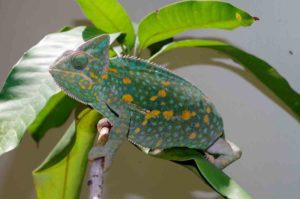
Mating Veiled chameleons is fairly straightforward if the female is receptive. The colouring is the best guideline, as she exhibits dozens of light blue spots. Even when she is displaying receptive colours, she may quickly change her mind when confronted by the male. If she opens her mouth and goes dark in colour, remove her immediately. If left with the male, she can become very aggressive and hurt the male even though he is often much larger than her.
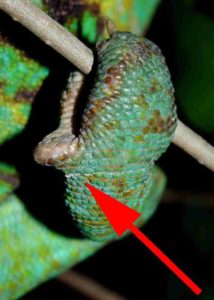
Eggs can be incubated at 26c and will take around 6 months to hatch. The neonates are very simple to rear and are quite robust. Sexing Veiled chameleons is fairly easy as this species is sexually dimorphic and the differences are evident from the moment they hatch.
Males have a spur on their rear feet even as soon as they exit the egg. It can be hard to see and is not always obvious. Their casques become more prominent as the males grow. The early months can dictate their later health, so only buy from a pet shop or Veiled chameleon breeders in which you have confidence and that exercise good knowledge of Veiled chameleon care. A few question asked will soon tell you how they care for Veiled chameleons!
Why are Female Veiled chameleons prone to MBD?
Female Veiled chameleons are more at risk from MBD than males as the production of eggs takes a huge toll on them. Females can produce anything up to 80 eggs produced in a single batch, possibly several times a year. Between batches of eggs try to strengthen her with a varied diet, good-quality calcium supplements and natural sunlight.
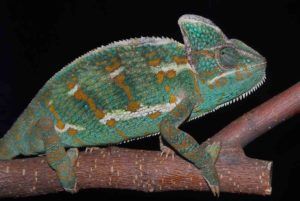
Another risk to the female is that they will often produce eggs around the age of 9 months (give or take a few months) even if they have not mated. Some unmated females become egg-bound, leading to an early death.
Is a Veiled chameleon a good pet?
I often asked ‘are Veiled chameleons good pets?’ The answer depends entirely on what the person means by a ‘pet’.
Do they want to take out the chameleon and ‘play’ with it? Put it on their arm or shoulder and walk around to impress their friends? Then obviously the answer is ‘no’! They might want to consider a cat or a dog.
A chameleon is easily stressed when handled or brought out into the open. The whole nature and focus of a chameleon is to remain camouflaged, hidden from sight. To be suddenly exposed is an unwelcome shock.
If, by ‘pet’, the person means responsibly looking after a fascinating creature, then absolutely – chameleons are great pets! Veiled chameleons are not the calmest chameleon species and some males tend to be unfriendly. In reality, it is a reptile, so it is neither friendly nor unfriendly, a concept alien to it. The stroppy males are probably simply being territorial.
That said, a Veiled chameleon is one of the easiest chameleons to care for, with the possible exception of the Panther chameleon. As discussed above, Veiled chameleon care is not difficult. Just follow a few simple rules. And if you’re not sure, ask questions.
If you would to read information about Veiled chameleons and other aspects of chameleon care, click here for our chameleon book page.
